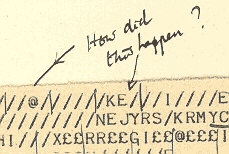Computer History
Explore each of these articles, which focus on the early history of computers and give some insight into the early history of computers. They will introduce you to the powerful ideas that enabled computer architecture of today and that will influence computer architecture of tomorrow.
Source Code as History
When the history of early software development is written, it will be a travesty. Few historians will have the ability, and even fewer the inclination, to learn long dead programming languages. History will be derived from the documentation not the source code. Alan Turing's perplexed, hand written annotation "How did this happen?" on a cutting of Autocode taped into his notebook will remain a mystery.

What kind of bug would stump Alan Turing? Was it merely a typo that took a few hours to find? a simple mistake maybe? Or did the discipline of the machine expose a fundamental misconception and thereby teach him a lesson? The only way to know would be to learn Autocode.

The first stored program to be successfully executed was written by Tom Kilburn and executed on Monday June 21, 1948 at Manchester University, England. It is said that this was the first and last program that Kilburn ever wrote. The program found the highest factor of a number and took 1 minute to complete on its first run. A second run with a different number took 2 minutes and 52 seconds. Unfortunately, no one thought to document the program until Geoffrey C. Tootill wrote an amended version in his notebook a month later on July 18, 1948. The original has been lost. Below is a copy of Tootill's version.
